Statistics Assignment: Regression, ANOVA, and Data Analysis Solutions
VerifiedAdded on 2023/06/06
|11
|1061
|430
Homework Assignment
AI Summary
This statistics assignment provides detailed solutions to various problems, including the interpretation of frequency distributions, linear regression models, and ANOVA tables. It analyzes the distribution of examination scores, explores the relationship between unit price and supply using regression, and conducts hypothesis testing to determine the significance of different factors. The assignment also includes a multiple regression analysis to predict weekly sales data based on competitor pricing and advertising expenditures, along with recommendations based on the statistical findings. Desklib offers this solution and many other resources to aid students in their studies, including past papers and solved assignments.
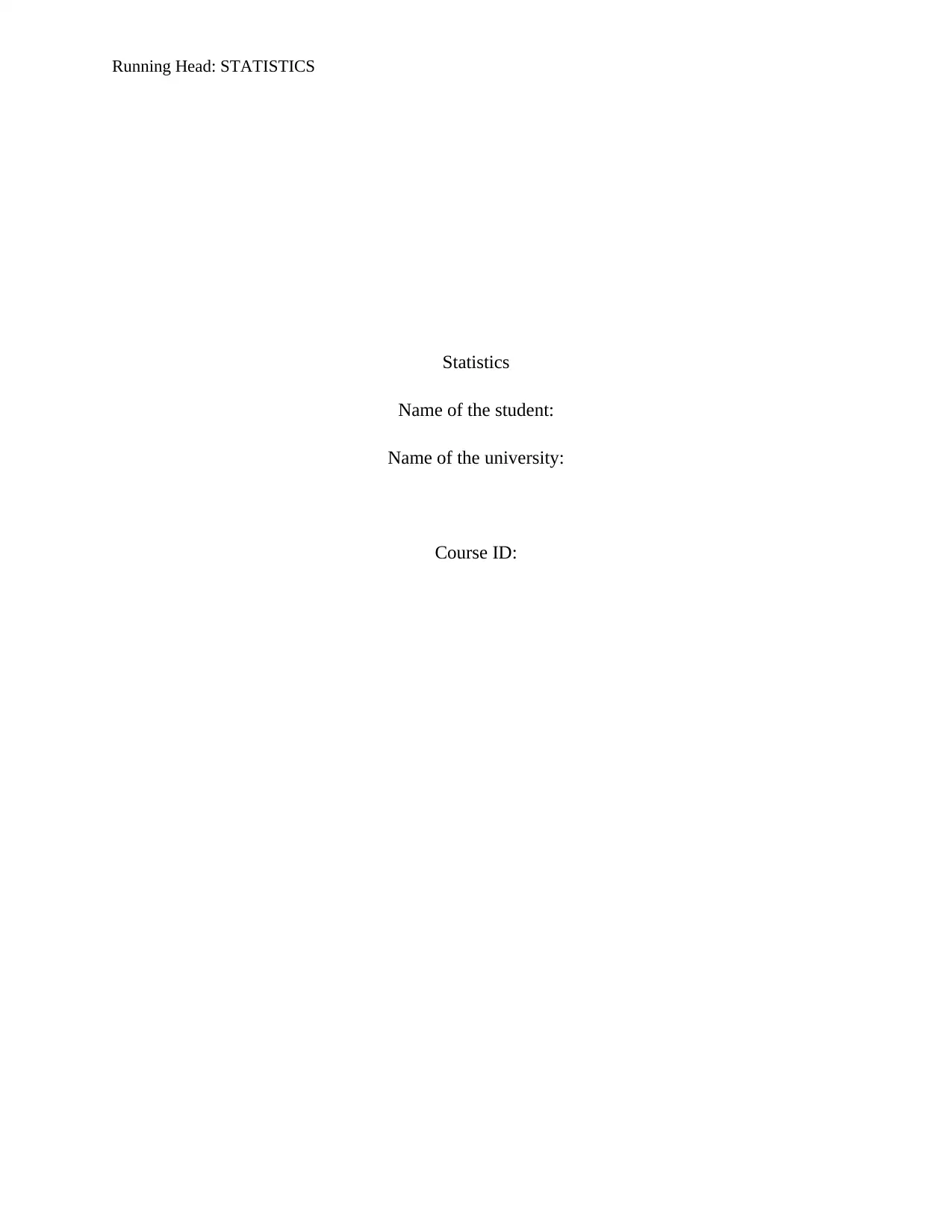
Running Head: STATISTICS
Statistics
Name of the student:
Name of the university:
Course ID:
Statistics
Name of the student:
Name of the university:
Course ID:
Paraphrase This Document
Need a fresh take? Get an instant paraphrase of this document with our AI Paraphraser
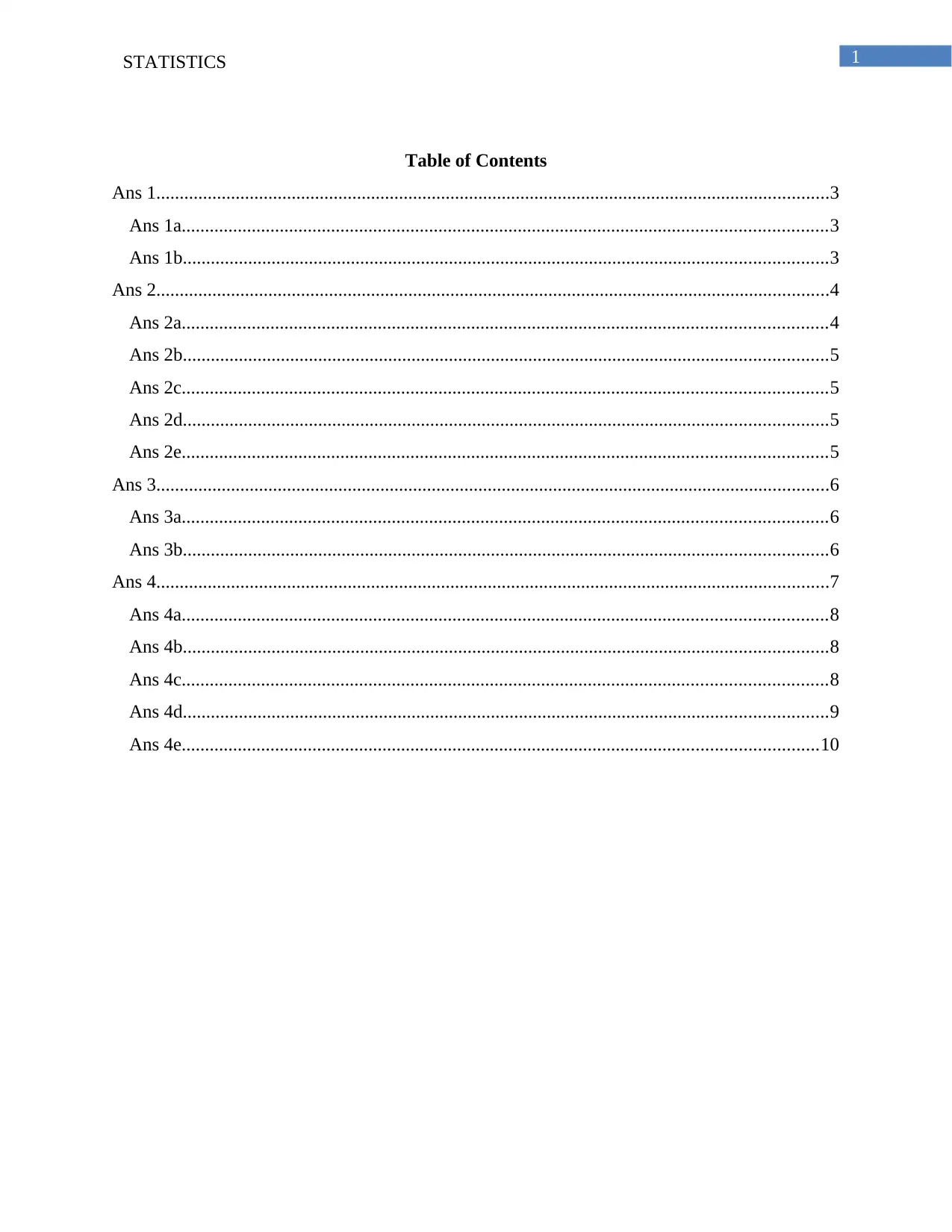
1STATISTICS
Table of Contents
Ans 1................................................................................................................................................3
Ans 1a..........................................................................................................................................3
Ans 1b..........................................................................................................................................3
Ans 2................................................................................................................................................4
Ans 2a..........................................................................................................................................4
Ans 2b..........................................................................................................................................5
Ans 2c..........................................................................................................................................5
Ans 2d..........................................................................................................................................5
Ans 2e..........................................................................................................................................5
Ans 3................................................................................................................................................6
Ans 3a..........................................................................................................................................6
Ans 3b..........................................................................................................................................6
Ans 4................................................................................................................................................7
Ans 4a..........................................................................................................................................8
Ans 4b..........................................................................................................................................8
Ans 4c..........................................................................................................................................8
Ans 4d..........................................................................................................................................9
Ans 4e........................................................................................................................................10
Table of Contents
Ans 1................................................................................................................................................3
Ans 1a..........................................................................................................................................3
Ans 1b..........................................................................................................................................3
Ans 2................................................................................................................................................4
Ans 2a..........................................................................................................................................4
Ans 2b..........................................................................................................................................5
Ans 2c..........................................................................................................................................5
Ans 2d..........................................................................................................................................5
Ans 2e..........................................................................................................................................5
Ans 3................................................................................................................................................6
Ans 3a..........................................................................................................................................6
Ans 3b..........................................................................................................................................6
Ans 4................................................................................................................................................7
Ans 4a..........................................................................................................................................8
Ans 4b..........................................................................................................................................8
Ans 4c..........................................................................................................................................8
Ans 4d..........................................................................................................................................9
Ans 4e........................................................................................................................................10
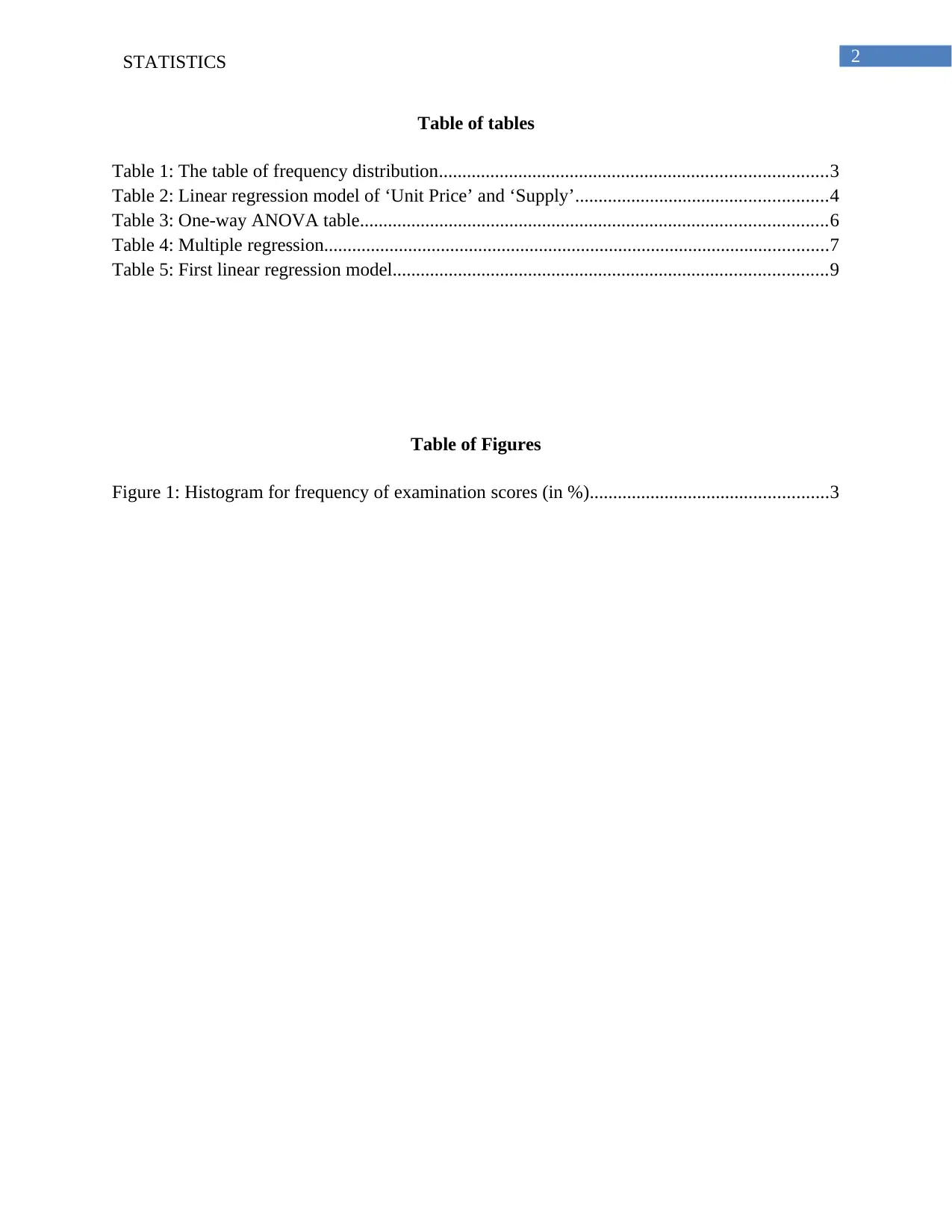
2STATISTICS
Table of tables
Table 1: The table of frequency distribution...................................................................................3
Table 2: Linear regression model of ‘Unit Price’ and ‘Supply’......................................................4
Table 3: One-way ANOVA table....................................................................................................6
Table 4: Multiple regression............................................................................................................7
Table 5: First linear regression model.............................................................................................9
Table of Figures
Figure 1: Histogram for frequency of examination scores (in %)...................................................3
Table of tables
Table 1: The table of frequency distribution...................................................................................3
Table 2: Linear regression model of ‘Unit Price’ and ‘Supply’......................................................4
Table 3: One-way ANOVA table....................................................................................................6
Table 4: Multiple regression............................................................................................................7
Table 5: First linear regression model.............................................................................................9
Table of Figures
Figure 1: Histogram for frequency of examination scores (in %)...................................................3
⊘ This is a preview!⊘
Do you want full access?
Subscribe today to unlock all pages.

Trusted by 1+ million students worldwide

3STATISTICS
Ans 1.
Ans 1a.
Table 1: The table of frequency distribution
Ans 1b.
Figure 1: Histogram for frequency of examination scores (in %)
The shape of the distribution of examination score of 20 students depicts that-
Ans 1.
Ans 1a.
Table 1: The table of frequency distribution
Ans 1b.
Figure 1: Histogram for frequency of examination scores (in %)
The shape of the distribution of examination score of 20 students depicts that-
Paraphrase This Document
Need a fresh take? Get an instant paraphrase of this document with our AI Paraphraser
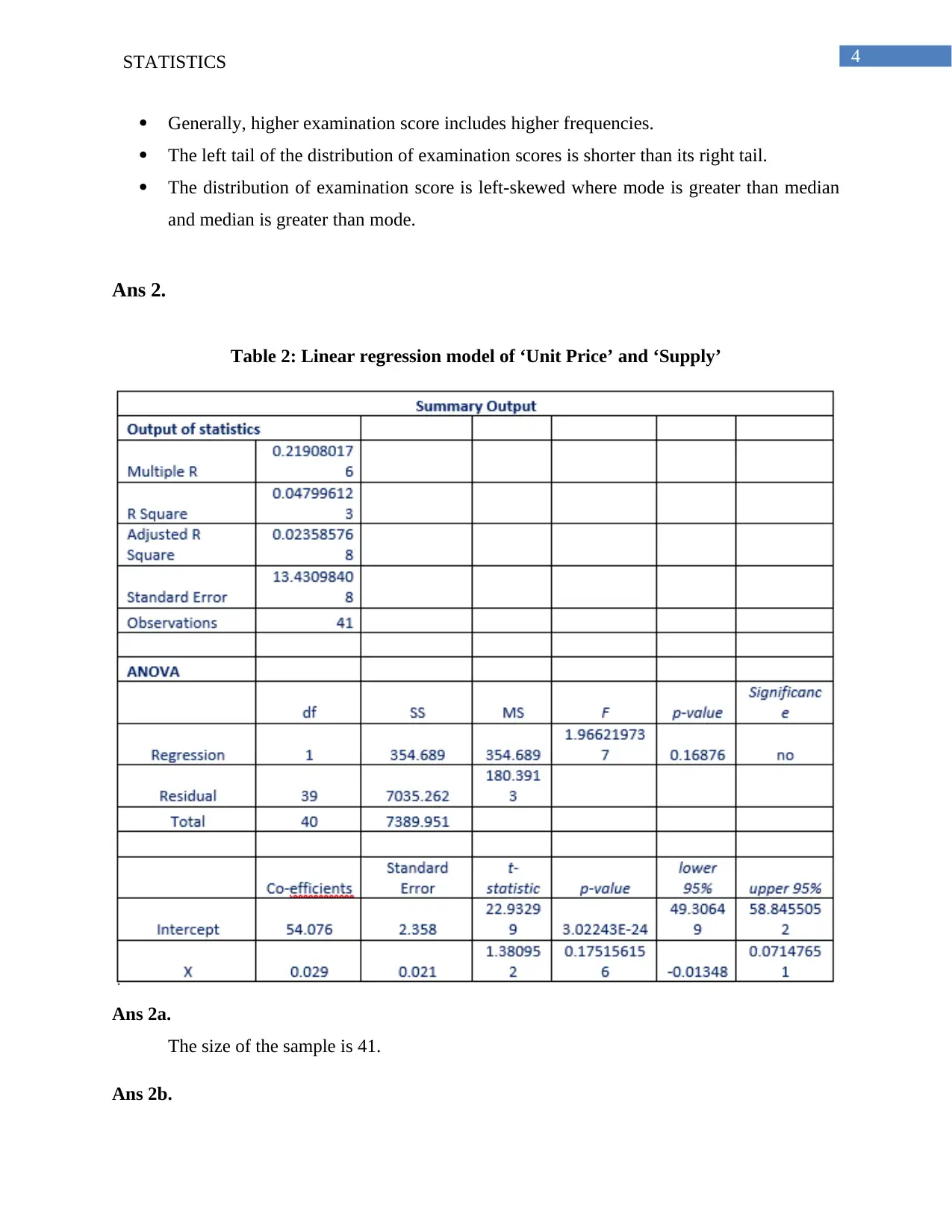
4STATISTICS
Generally, higher examination score includes higher frequencies.
The left tail of the distribution of examination scores is shorter than its right tail.
The distribution of examination score is left-skewed where mode is greater than median
and median is greater than mode.
Ans 2.
Table 2: Linear regression model of ‘Unit Price’ and ‘Supply’
Ans 2a.
The size of the sample is 41.
Ans 2b.
Generally, higher examination score includes higher frequencies.
The left tail of the distribution of examination scores is shorter than its right tail.
The distribution of examination score is left-skewed where mode is greater than median
and median is greater than mode.
Ans 2.
Table 2: Linear regression model of ‘Unit Price’ and ‘Supply’
Ans 2a.
The size of the sample is 41.
Ans 2b.
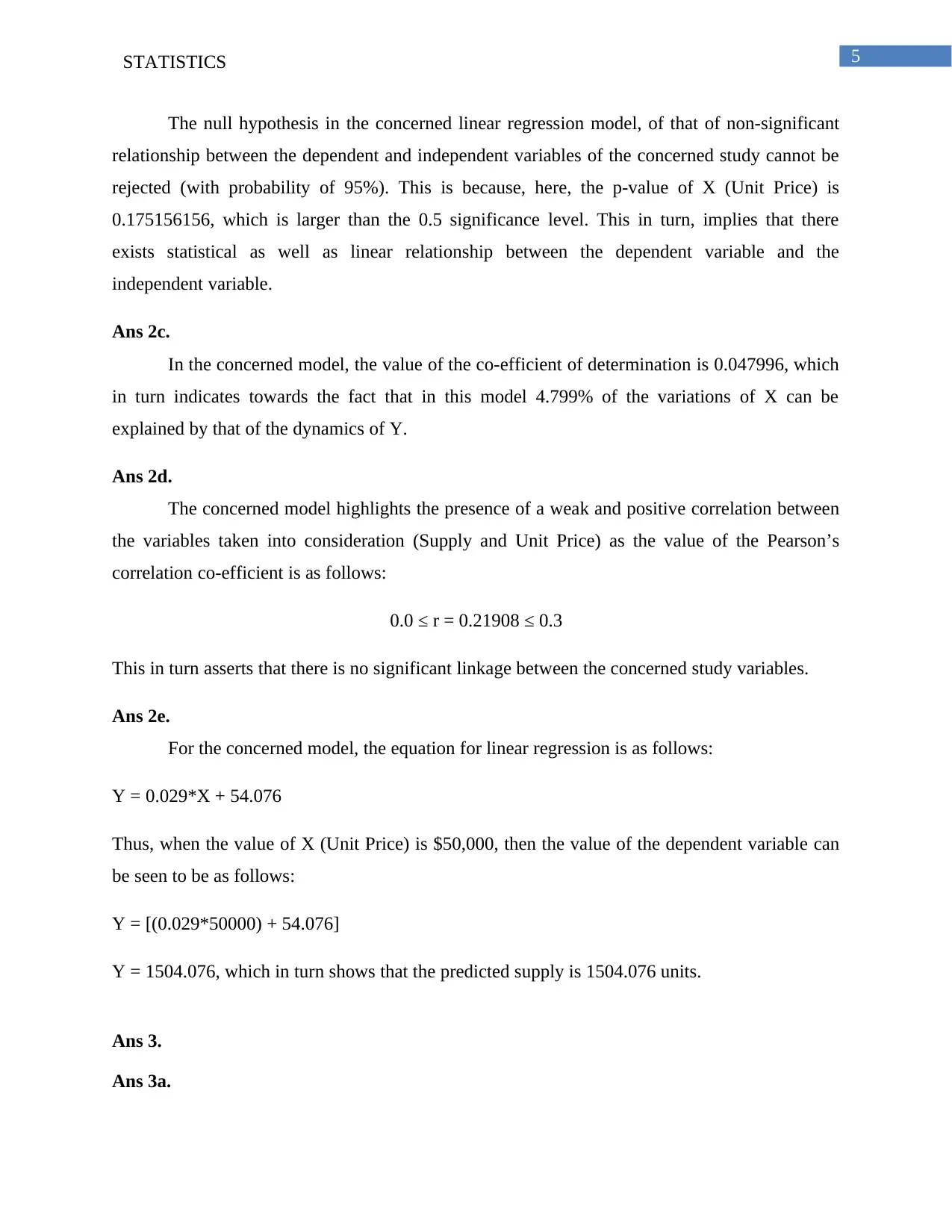
5STATISTICS
The null hypothesis in the concerned linear regression model, of that of non-significant
relationship between the dependent and independent variables of the concerned study cannot be
rejected (with probability of 95%). This is because, here, the p-value of X (Unit Price) is
0.175156156, which is larger than the 0.5 significance level. This in turn, implies that there
exists statistical as well as linear relationship between the dependent variable and the
independent variable.
Ans 2c.
In the concerned model, the value of the co-efficient of determination is 0.047996, which
in turn indicates towards the fact that in this model 4.799% of the variations of X can be
explained by that of the dynamics of Y.
Ans 2d.
The concerned model highlights the presence of a weak and positive correlation between
the variables taken into consideration (Supply and Unit Price) as the value of the Pearson’s
correlation co-efficient is as follows:
0.0 ≤ r = 0.21908 ≤ 0.3
This in turn asserts that there is no significant linkage between the concerned study variables.
Ans 2e.
For the concerned model, the equation for linear regression is as follows:
Y = 0.029*X + 54.076
Thus, when the value of X (Unit Price) is $50,000, then the value of the dependent variable can
be seen to be as follows:
Y = [(0.029*50000) + 54.076]
Y = 1504.076, which in turn shows that the predicted supply is 1504.076 units.
Ans 3.
Ans 3a.
The null hypothesis in the concerned linear regression model, of that of non-significant
relationship between the dependent and independent variables of the concerned study cannot be
rejected (with probability of 95%). This is because, here, the p-value of X (Unit Price) is
0.175156156, which is larger than the 0.5 significance level. This in turn, implies that there
exists statistical as well as linear relationship between the dependent variable and the
independent variable.
Ans 2c.
In the concerned model, the value of the co-efficient of determination is 0.047996, which
in turn indicates towards the fact that in this model 4.799% of the variations of X can be
explained by that of the dynamics of Y.
Ans 2d.
The concerned model highlights the presence of a weak and positive correlation between
the variables taken into consideration (Supply and Unit Price) as the value of the Pearson’s
correlation co-efficient is as follows:
0.0 ≤ r = 0.21908 ≤ 0.3
This in turn asserts that there is no significant linkage between the concerned study variables.
Ans 2e.
For the concerned model, the equation for linear regression is as follows:
Y = 0.029*X + 54.076
Thus, when the value of X (Unit Price) is $50,000, then the value of the dependent variable can
be seen to be as follows:
Y = [(0.029*50000) + 54.076]
Y = 1504.076, which in turn shows that the predicted supply is 1504.076 units.
Ans 3.
Ans 3a.
⊘ This is a preview!⊘
Do you want full access?
Subscribe today to unlock all pages.

Trusted by 1+ million students worldwide

6STATISTICS
Table 3: One-way ANOVA table
Ans 3b.
The hypotheses formed at 5% significance level are as follows:
H0: Mean scores of the programs equals one another.
H1: There is one or more in-equality among the mean scores of all the programs.
The null hypothesis, in this case can be rejected at the 95% probability level as the p-
value (0.00557) of the F-statistics (6.140351) is lower than that of the 5% significance level.
Thus, by accepting the alternative hypothesis, it can be seen that the workers in the Program C
are more productive than those in rest of the programs.
Recommendation- The programmers in Program C are more effective and thus should be more
acceptable.
Ans 4.
Here, the data is recorded as follows:
Table 3: One-way ANOVA table
Ans 3b.
The hypotheses formed at 5% significance level are as follows:
H0: Mean scores of the programs equals one another.
H1: There is one or more in-equality among the mean scores of all the programs.
The null hypothesis, in this case can be rejected at the 95% probability level as the p-
value (0.00557) of the F-statistics (6.140351) is lower than that of the 5% significance level.
Thus, by accepting the alternative hypothesis, it can be seen that the workers in the Program C
are more productive than those in rest of the programs.
Recommendation- The programmers in Program C are more effective and thus should be more
acceptable.
Ans 4.
Here, the data is recorded as follows:
Paraphrase This Document
Need a fresh take? Get an instant paraphrase of this document with our AI Paraphraser
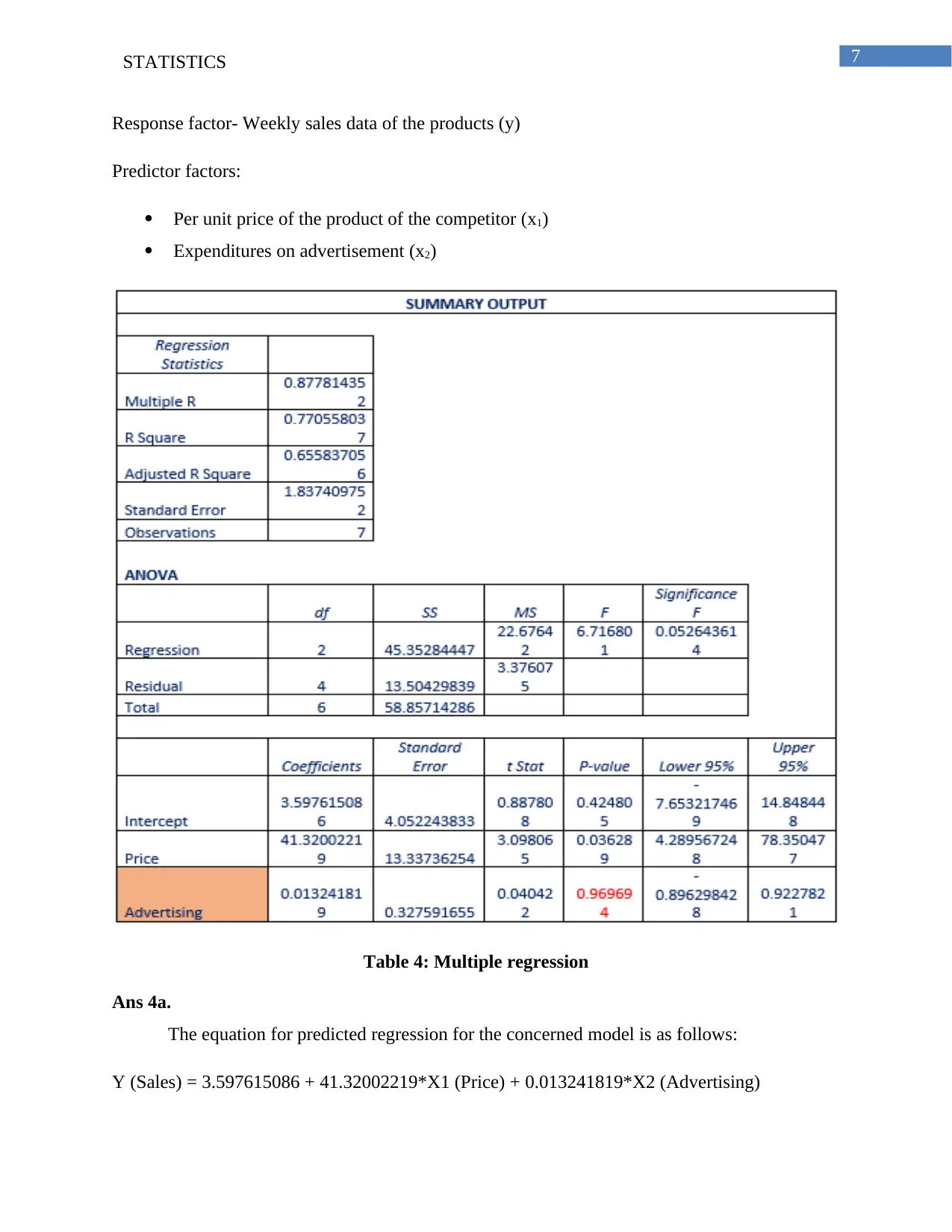
7STATISTICS
Response factor- Weekly sales data of the products (y)
Predictor factors:
Per unit price of the product of the competitor (x1)
Expenditures on advertisement (x2)
Table 4: Multiple regression
Ans 4a.
The equation for predicted regression for the concerned model is as follows:
Y (Sales) = 3.597615086 + 41.32002219*X1 (Price) + 0.013241819*X2 (Advertising)
Response factor- Weekly sales data of the products (y)
Predictor factors:
Per unit price of the product of the competitor (x1)
Expenditures on advertisement (x2)
Table 4: Multiple regression
Ans 4a.
The equation for predicted regression for the concerned model is as follows:
Y (Sales) = 3.597615086 + 41.32002219*X1 (Price) + 0.013241819*X2 (Advertising)
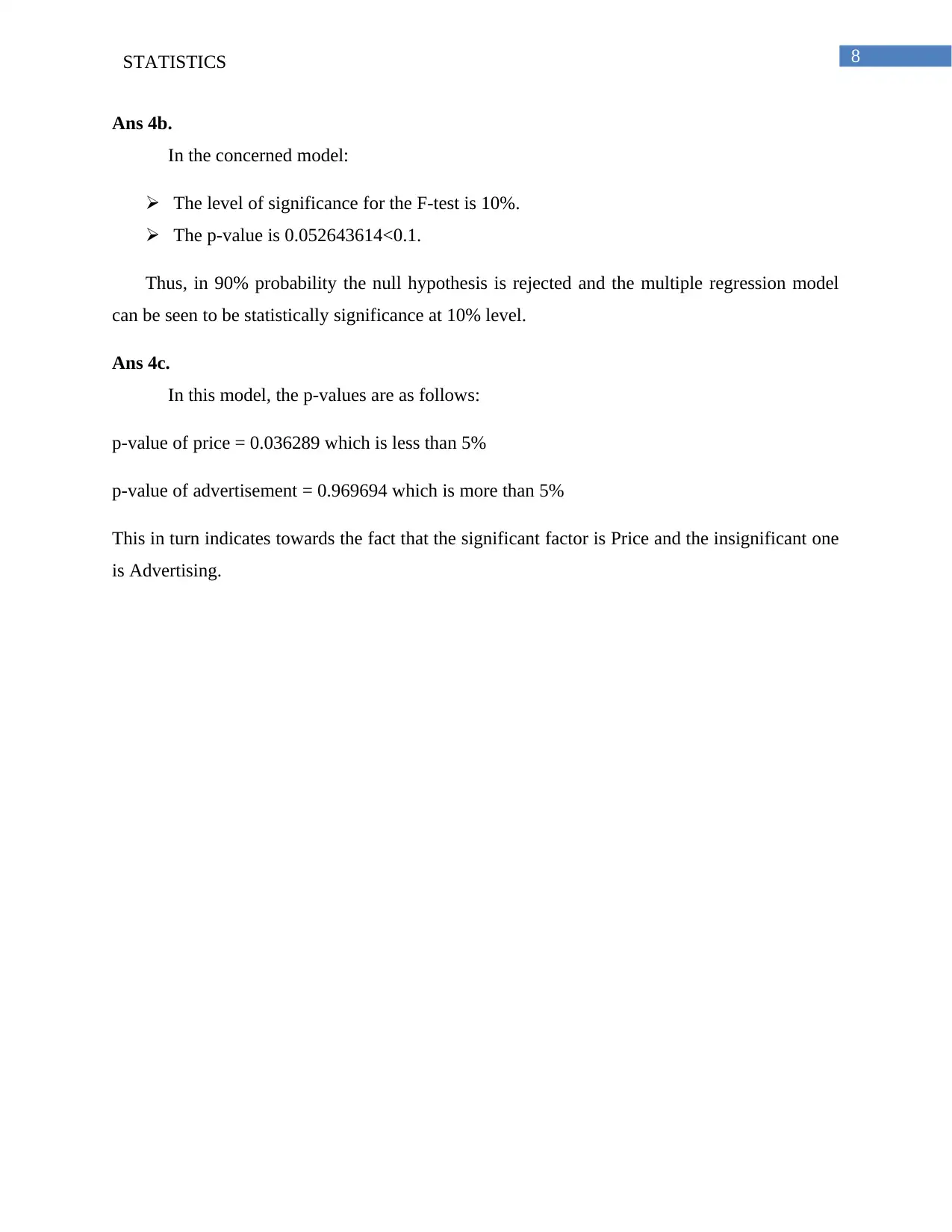
8STATISTICS
Ans 4b.
In the concerned model:
The level of significance for the F-test is 10%.
The p-value is 0.052643614<0.1.
Thus, in 90% probability the null hypothesis is rejected and the multiple regression model
can be seen to be statistically significance at 10% level.
Ans 4c.
In this model, the p-values are as follows:
p-value of price = 0.036289 which is less than 5%
p-value of advertisement = 0.969694 which is more than 5%
This in turn indicates towards the fact that the significant factor is Price and the insignificant one
is Advertising.
Ans 4b.
In the concerned model:
The level of significance for the F-test is 10%.
The p-value is 0.052643614<0.1.
Thus, in 90% probability the null hypothesis is rejected and the multiple regression model
can be seen to be statistically significance at 10% level.
Ans 4c.
In this model, the p-values are as follows:
p-value of price = 0.036289 which is less than 5%
p-value of advertisement = 0.969694 which is more than 5%
This in turn indicates towards the fact that the significant factor is Price and the insignificant one
is Advertising.
⊘ This is a preview!⊘
Do you want full access?
Subscribe today to unlock all pages.

Trusted by 1+ million students worldwide
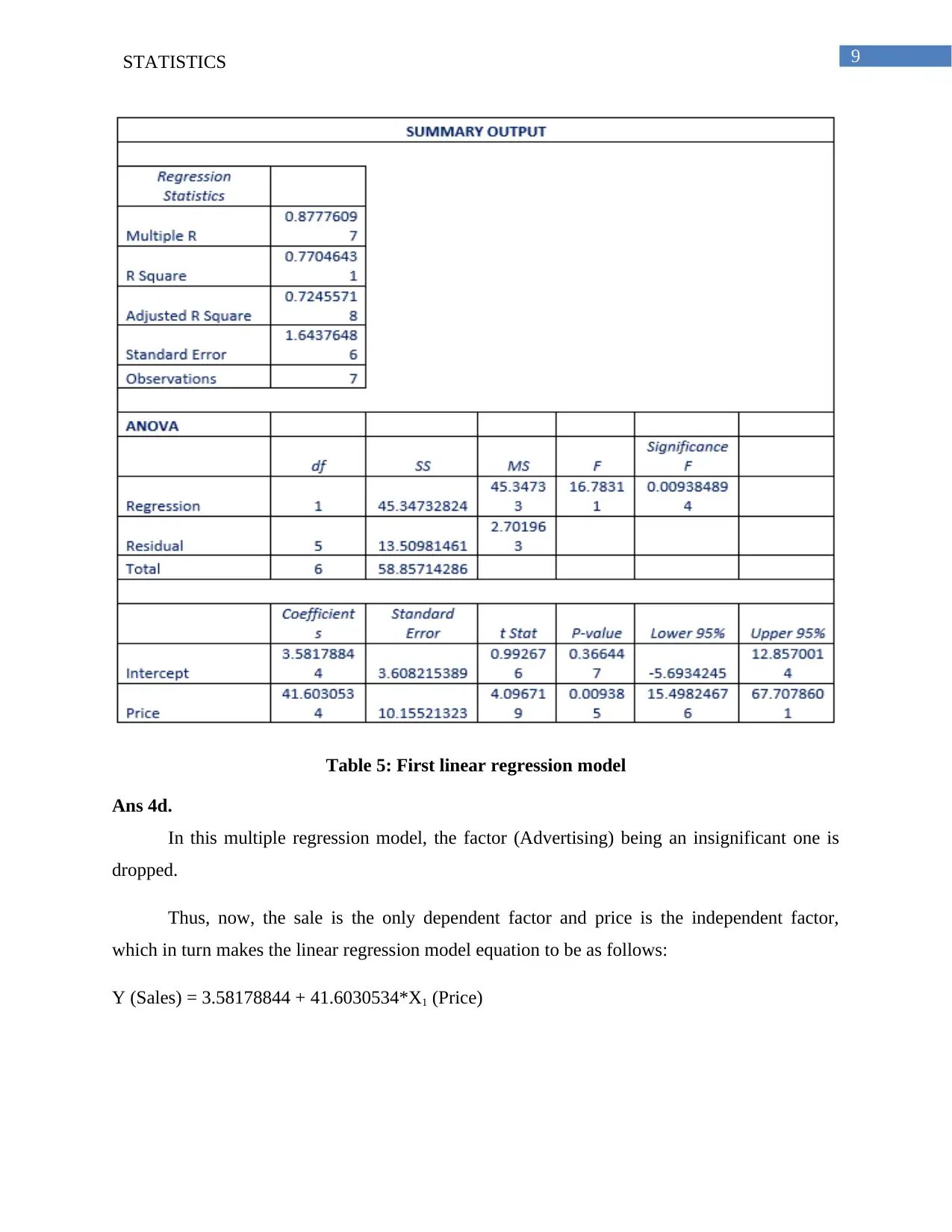
9STATISTICS
Table 5: First linear regression model
Ans 4d.
In this multiple regression model, the factor (Advertising) being an insignificant one is
dropped.
Thus, now, the sale is the only dependent factor and price is the independent factor,
which in turn makes the linear regression model equation to be as follows:
Y (Sales) = 3.58178844 + 41.6030534*X1 (Price)
Table 5: First linear regression model
Ans 4d.
In this multiple regression model, the factor (Advertising) being an insignificant one is
dropped.
Thus, now, the sale is the only dependent factor and price is the independent factor,
which in turn makes the linear regression model equation to be as follows:
Y (Sales) = 3.58178844 + 41.6030534*X1 (Price)
Paraphrase This Document
Need a fresh take? Get an instant paraphrase of this document with our AI Paraphraser
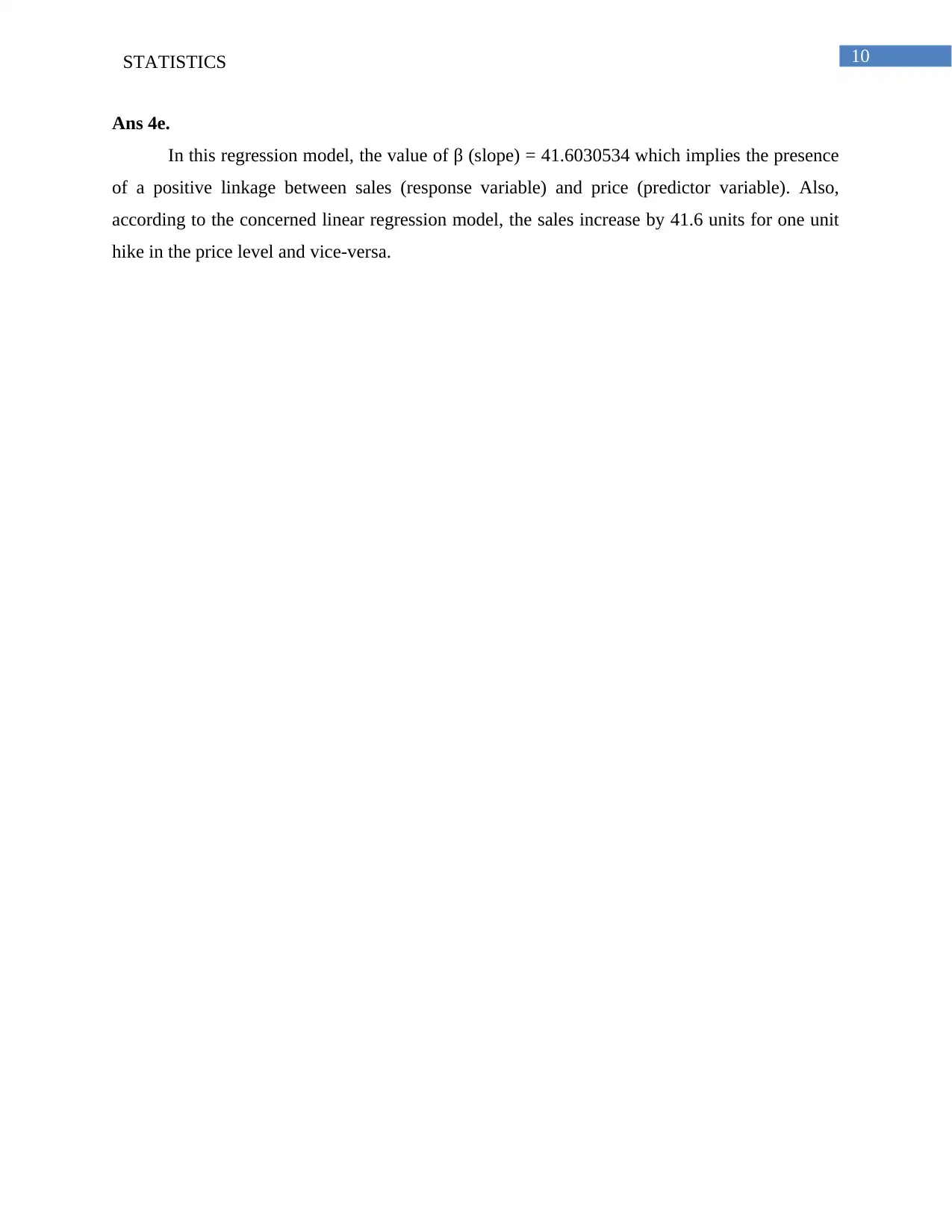
10STATISTICS
Ans 4e.
In this regression model, the value of β (slope) = 41.6030534 which implies the presence
of a positive linkage between sales (response variable) and price (predictor variable). Also,
according to the concerned linear regression model, the sales increase by 41.6 units for one unit
hike in the price level and vice-versa.
Ans 4e.
In this regression model, the value of β (slope) = 41.6030534 which implies the presence
of a positive linkage between sales (response variable) and price (predictor variable). Also,
according to the concerned linear regression model, the sales increase by 41.6 units for one unit
hike in the price level and vice-versa.
1 out of 11
Related Documents
Your All-in-One AI-Powered Toolkit for Academic Success.
+13062052269
info@desklib.com
Available 24*7 on WhatsApp / Email
![[object Object]](/_next/static/media/star-bottom.7253800d.svg)
Unlock your academic potential
Copyright © 2020–2025 A2Z Services. All Rights Reserved. Developed and managed by ZUCOL.





